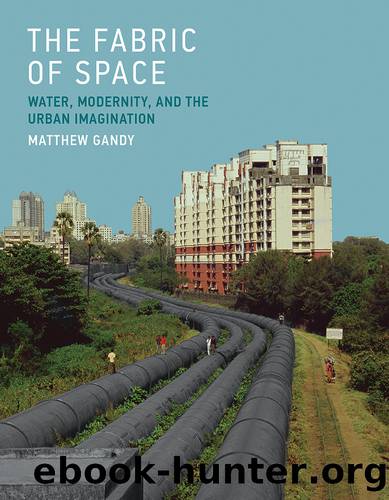The Fabric of Space by Matthew Gandy

Author:Matthew Gandy [Gandy, Matthew]
Language: eng
Format: epub
Tags: Environment, Urban Studies
ISBN: 9780262028257
Publisher: The MIT Press
Published: 2014-06-14T16:00:00+00:00
Figure 6.5
Rainham Marshes, Essex (2010). Photo: Matthew Gandy.
The Thames estuary forms part of London’s natural flood defenses, since these low-lying areas would help to reduce the impact of a tidal surge before it reached the city. A recent report by the Royal Institute of British Architects suggests the creation of a series of new tidal lagoons to help reduce flood risk, thereby combining landscape architecture with flood control.67 The role of ecosystems in mitigating environmental threats has sometimes been referred to as “ecological infrastructure,” a term that has its origins in the early 1980s and now encompasses aims such as the control of surface runoff, the lessening of the urban heat island effect, and new approaches to waste water treatment.68 The Greater London Authority’s London Plan, published in 2011, has emphasized a shift toward regarding green space as a form of “green infrastructure” linked to what has been termed the All London Green Grid, within which rivers and waterways are expected to play a distinctive role.69 The increasing prominence and malleability of the term “infrastructure” in planning discourse for London marks a movement away from its earlier predominantly technical usage to encompass a much wider range of developments. Yet the utilitarian impulse behind the idea of ecological or green infrastructure does not capture the full range of social, cultural, or scientific discourses associated with urban nature. The estuary has long been a source of inspiration for artists and photographers, who emphasize its “wildness” and comparative tranquillity, and these spaces have also acquired significance for scientific interest and environmental education.70
An enhanced role for the Thames estuary in mediating flood risk marks a shift of emphasis away from more elaborate physical defense structures toward developing new types of interaction with water.71 At a national level this change of approach toward greater accommodation of flood risk was signaled by the UK government’s policy document Making Space for Water, published in 2005. The document, based on a wide-ranging consultation exercise, introduces a more holistic approach to flood control that acknowledges the fiscal and practical limits to reliance on physical defenses. It emphasizes instead a greater range of land use options to control floods, including the creation of “washlands” and wetlands and the strategic abandonment of some sites susceptible to flooding or coastal erosion (a process referred to as “managed realignment”).72 The consultation has elicited a range of responses including many from organizations not hitherto closely engaged in flood control, as part of a more broadly defined understanding of the relationship between water and public policy.73
The complexity of an ecologically oriented approach to flood risk management contrasts with the relative simplicity of the technomanagerial paradigm. The development of a floodplain-oriented approach implies a different kind of relationship between scientific expertise and society since a much greater range of factors are involved, including questions of land use, landscape design, and intersections with other social and environmental objectives.74 Within the London area there have already been some attempts to extend floodplain ecosystems for tributaries of the Thames.
Download
This site does not store any files on its server. We only index and link to content provided by other sites. Please contact the content providers to delete copyright contents if any and email us, we'll remove relevant links or contents immediately.
| Acoustics | Bridges |
| Earthwork Design | Environmental |
| Fire Science | Highway & Traffic |
| Hydrology | Remote Sensing |
| Seismic Design | Structural |
| Structural Dynamics | Surveying & Photogrammetry |
| Transportation |
Whiskies Galore by Ian Buxton(40299)
Introduction to Aircraft Design (Cambridge Aerospace Series) by John P. Fielding(32331)
Small Unmanned Fixed-wing Aircraft Design by Andrew J. Keane Andras Sobester James P. Scanlan & András Sóbester & James P. Scanlan(32136)
Craft Beer for the Homebrewer by Michael Agnew(17439)
Turbulence by E. J. Noyes(7032)
The Complete Stick Figure Physics Tutorials by Allen Sarah(6631)
Kaplan MCAT General Chemistry Review by Kaplan(6044)
The Thirst by Nesbo Jo(5778)
Bad Blood by John Carreyrou(5761)
Learning SQL by Alan Beaulieu(5399)
Weapons of Math Destruction by Cathy O'Neil(5030)
Man-made Catastrophes and Risk Information Concealment by Dmitry Chernov & Didier Sornette(4728)
iGen by Jean M. Twenge(4693)
Digital Minimalism by Cal Newport;(4511)
Life 3.0: Being Human in the Age of Artificial Intelligence by Tegmark Max(4493)
Audition by Ryu Murakami(4091)
1,001 ASVAB Practice Questions For Dummies by Powers Rod(4034)
Electronic Devices & Circuits by Jacob Millman & Christos C. Halkias(4021)
Pale Blue Dot by Carl Sagan(3996)
